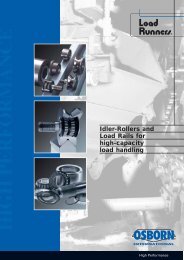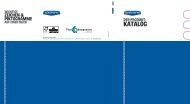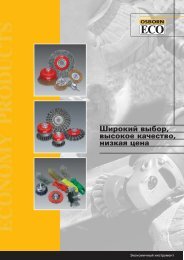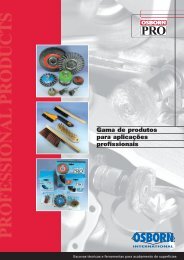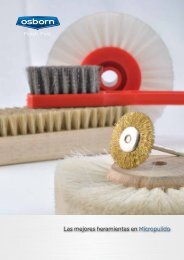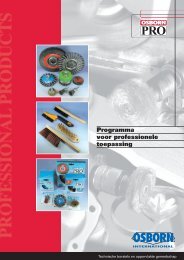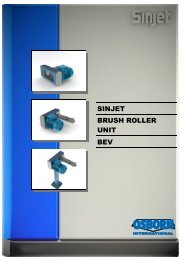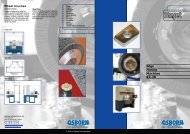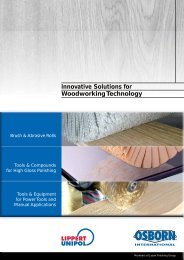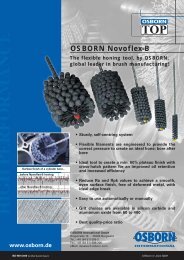Create successful ePaper yourself
Turn your PDF publications into a flip-book with our unique Google optimized e-Paper software.
BRUSHES<br />
Introduction & technical information<br />
Trim materials: the right material for every application<br />
For our high end products, we only use trim materials that we have developed ourselves or which have been specifically<br />
selected. Constant laboratory tests ensure high material quality. Your Osborn tool is always perfectly suited to a certain<br />
type of brushing work. Our technical sales department will be pleased to advise you on the ideal trim material for your given<br />
application.<br />
Steel wire, crimped<br />
• Most common trimming material<br />
• For flexible brushing tools<br />
• Suitable for light surface treatment and deburring operations<br />
Brass-coated steel wire, cord wire<br />
• Cord wire with high tensile strength<br />
• For demanding brushing and deburring operations,<br />
suitable for structuring<br />
Steel wire, straight or knotted<br />
• For extreme brushing requirements<br />
• For brushing tools with less flexibility<br />
• Ideal for cleaning weld seam and removing heavy deposits of<br />
scale or corrosion<br />
Tampico fibre<br />
• Pure plant fibre<br />
• For wet and dry cleaning operations<br />
• Heat-resistant<br />
• In combination with compound also suitable for polishing<br />
Osborn special steel wire, crimped or knotted<br />
• Heavy duty steel wire with high tensile strength<br />
• High elongation and long brush life<br />
• For extreme brushing demands<br />
Horse hair<br />
• Animal hair<br />
• For light cleaning operations<br />
• Suitable for sealing<br />
Stainless steel wire, crimped, straight or knotted<br />
• Most commonly used alloy 1.4310 (1.4401/ 1.4571 available on request)<br />
• This wire is used where residue from normal steel wire would<br />
contaminate surfaces such as stainless steel, aluminium and<br />
other non-ferrous metals.<br />
Synthetic filaments<br />
• Highly flexible<br />
• Resistant to weak acids and alkaline solutions<br />
• Wear resistant<br />
Brass wire<br />
• Surface finishing on non-ferrous materials (copper and brass)<br />
Abrasive filament, aluminium oxide<br />
• Nylon filaments impregnated with abrasive grit<br />
• Light deburring of steel and non-ferrous metals<br />
Brass-coated steel wire, mono wire<br />
• Single wires<br />
• High tensile strength<br />
• For demanding brushing and deburring operations<br />
Novoflex-B<br />
• Abrasive spheres on a flexible structure<br />
• Self-centring<br />
• Creation of surfaces with a high contact ratio<br />
(plateau finish)<br />
Abrasive filament, silicon carbide<br />
• Nylon filaments impregnated with silicon carbide<br />
• Uniform performance as new abrasive particles come to the surface<br />
• High elasticity with no danger of breakage<br />
• Long brush life<br />
• For deburring/descaling, roughening and grinding<br />
Novofil<br />
• High-performance, high-tech material<br />
• Flat or round filaments<br />
• Broad range of materials, different degrees of hardness<br />
• For deburring and internal finishing<br />
Brush trim and material suitability.<br />
The trim material determines the suitability of the selected<br />
brush for the surface to be finished.<br />
A quick overview of the suitability of your brush can be found<br />
in the trim and material charts in the info headings on the<br />
product pages.<br />
TRIM AND MATERIAL<br />
Product available with:<br />
Steel wire, crimped<br />
Steel wire, stainless<br />
Brass wire<br />
Steel<br />
Cast iron<br />
Stainless steel<br />
Non-ferrous metal<br />
Aluminium<br />
Softwood<br />
Hardwood<br />
Simple equation:<br />
the right trim for the material being finished.<br />
11



